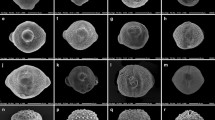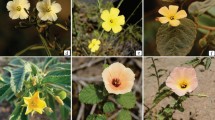Abstract
The small South-American genus Poecilanthe has a striking morphological diversity in leaf type, inflorescence, seed morphology and chemical composition. Recent phylogenetic work also shows that Poecilanthe is paraphyletic. Despite the importance of palynology to better understand morphological diversity and potentially inform evolutionary analyses, the pollen morphology of Poecilanthe and most of its close relatives is unknown. This study uses light and electronic microscopy to describe the pollen morphology of eight species of Poecilanthe and the four related genera Ormosia, Harpalyce, Clathrotropis and Cyclolobium. We found pollen grains colpate only in four species of Poecilanthe and Harpalyce brasiliana and colporate pollen grains in the other four Poecilanthe species and the other related genera (Ormosia, Clathrotropis and Cyclolobium). An identification key for pollen of all species is provided. Using principal component analyses (PCA) we found that pollen grains of the Poecilanthe have considerable diversity. However, only limited correspondence between the PCA clusters and the Poecilanthe clades was found, suggesting that pollinic characters do not reflect evolutionary history in this group.





Similar content being viewed by others
References
Abreu VHR, Bove CP, Philbrick CT, Mendonça CBF, Gonçalves-Esteves VL (2012) Pollen morphology of the aquatic Brazilian endemic genus Castelnavia Tul. & Wedd. (Podostemaceae). Plant Syst Evol 298:1455–1461
Aguiar ACA, Gonçalves VM, Gonçalves-Esteves V, Yamamoto K (2008) Palynotaxonomy of Brazilian species of Polygala. Bot J Linn Soc 157:609–619
Arroyo MTK (1976) The systematics of the legume genus Harpalyce (Leguminosae: Lotoideae). Mem N Y Bot Gard 26(4):1–8
Barth OM (1964) Catálogo sistemático dos polens das plantas arboreas do Brasil Meridional V—Leguminosae: Papilionatae. Mem Inst Oswaldo Cruz Rio de Janeiro 62:95–123
Cardoso D, Queiroz LP, Pennington RT, Lima HC, Fonty E, Wojciechowski MF, Lavin M (2012) Revisiting the phylogeny of Papilionoid legumes: new insights from comprehensively sampled early-branching lineages. Am J Bot 99(12):1991–2013
Doyle JJ, Chappill JA, Bailey CD, Kajita T (2000) Towards a comprehensive phylogeny of legumes: evidence from rbcL sequences and non-molecular data. In: Herendeen PS, Bruneau A (eds) Advances in legume systematics. Part 9. Royal Botanic Gardens, Kew
Erdtman G (1960) Pollen morphology and plant taxonomy. In: Angiosperms an introduction to palynology, 2nd edn. Stockholm Almquist & Wikseus
Faegri G, Iversen J (1966) Textbook of modern pollen analysis. In: Copenhagen: Scandinavian University books, 2nd edn.
Ferguson IK, Skvarla JJ (1981) The pollen morphology of the subfamily Papilionoideae (Leguminosae). In: Polhill RM, Raven PH (eds) Advances in legume systematics, v.2. Royal Botanic Gardens, Kew
Geesink R (1981) Tephrosieae. In: Polhill RM, Raven PH (eds) Advances in legume systematics. Part 1. The Royal Botanic Gardens, Kew
Greinwald R, Bachmann P, Lewis G, Witte L, Czygan FC (1995) Alkaloids of the genus Poecilanthe (Leguminosae: Papilionoideae). Bio Syst Ecol 23(5):547–553
Hu JM, Lavin M, Wojciechowski MF, Sanderson MJ (2000) Phylogenetic systematics of the tribe Millettieae (Leguminosae) based on chloroplast trnK/matK sequences and its implications for evolutionary patterns in Papilionoideae. A J Bot 87(3):418–430
Kirkbride JH, Gunn CR, Weitzman AL (2003) Fruits and seeds of genera in the subfamily Faboideae (Fabaceae). US Department Agriculture Tech Bull 1890:1–212
Lewis GP (1987) Legumes of Bahia. The Royal Botanic Gardens, Kew
Meireles JE (2007) Revisão taxonômica e filogenia de Poecilanthe s.l. (Leguminosae. Papilionoideae. Brongniartieae). Dissertação de Mestrado, Univ. Est. de Campinas
Meireles JE, Lima HC (2013) A new species of Poecilanthe (Leguminosae, Papilionoideae, Brongniartieae) from Southeastern Brazil. Phytotaxa 116(2):57–60
Meireles JE, Tozzi AMG (2007) A synopsis of the genus Poecilanthe (Leguminosae, Papilionoideae, Brongniartieae). Rodriguésia 58(2):255–264
Meireles JE, Tozzi AMG (2008) Seed and embryo morphology of Poecilanthe (Fabaceae, Papilionoideae, Brongniartieae). Bot J Linn Soc 158:249–256
Melhem TS, Cruz-Barros MAV, Corrêa AMS, Makino-Watanabe H, Silvestre-Capelato Esteves VLG (2003) Variabilidade polínica em plantas de Campos do Jordão (São Paulo, Brasil). Bol Inst Bot São Paulo 16:1–104
Moreira FF, Vaz AMSF, Mendonça CBF, Goncalves-Esteves V (2013) The systematic value of pollen morphology in trees and shrubs species of Bauhinia L. (Caesalpinioideae subg. Bauhinia-sect. Pauletia) occurring in Brazil. Acta Bot Bras 27:400–417
Pennington RT, Lavin M, Ireland H, Klitgaard B, Preston J, Hu J (2001) Pylogenetic relationships of basal papilionoid legumes based upon sequences of the chloroplast trnL intron. Syst Bot 26(3):537–556
Punt W, Blackmore S, Nilsson S, Le Thomas A (2007) Glossary of pollen and spore terminology. Rev Paleo and Palynol 143:1–81
R Core Team (2013) R: a language and environment for statistical computing. R Foundation for Statistical Computing, Vienna, Austria. URL http://www.R-project.org/
Raynal A, Raynal J (1971) Une technique de préparation des grains de pollen fragilis. Adansonia 11(1):77–79
Salgado-Labouriau ML (1973) Contribuição à Palinologia dos Cerrados. Rio de Janeiro: Academia Brasileira de Ciências, p 291
Silvestre-Capelato MSF, Melhem TS (1997) Flora polínica da Reserva do Parque Estadual das Fontes do Ipiranga (São Paulo, Brasil). Família: 81—Leguminosae. Hoehnea 24(1):115–163
Thiers B (2010) Index herbariorum: a global directory of public herbaria and associated staff. New York Bot Gard Virtual Herbarium. http://sweetgum.nybg.org/ih/
Wojciechowski MF, Lavin M, Sanderson MJ (2004) A phylogeny of legumes (Leguminosae) based on analysis of the plastid matK gene resolves many well-supported subclades within the family. A J Bot 91(11):1846–1862
Acknowledgments
We are grateful to Noêmia Rodrigues Gonçalves (Instituto de Biofísica-UFRJ) who helped with the SEM. This work was supported by Conselho Nacional de Desenvolvimento Científico e Tecnológico (CNPq) and Fundação de Amparo a Pesquisa do Estado do Rio de Janeiro (FAPERJ).
Author information
Authors and Affiliations
Corresponding author
Additional information
This is the part of the thesis of the F. C. de Souza’s Master Degree in Ciências Biológicas (Botânica).
V. Gonçalves-Esteves recieved CNPq productivity scholarship.
Appendices
Appendix 1
Voucher of the specimens of species of the Poecilanthe and related genera (Fabaceae, Papilionoideae, Brongniartieae) examined:
Poecilanthe amazonica (Ducke) Ducke.—Brazil, Amazonas, Rio Abacaxis, 06/VII/1983, J.L. Zarucchi 2968 (RB); Rio Iguapó, Tupana, 23/III/1974, D.G. Campebell P20875 et al. (INPA); Entre o Rio Castanho e o Araçá, 13/VIII/1972, *M. Silva 671 (RB); Rio Guamã, V/1977, O.P. Monteiro 1407 et al. (INPA).
Poecilanthe effusa (Huber) Ducke.—Brazil, Acre, Município de Brasiléia, Seringal Poromgaba, 01/XI/1991, D.C. Daly 7087 et al. (NY);. Maranhão, Ipixuna, 06/VII/1966, A.P. Duarte 9811 (HB); Pará, Municipio de Oriximiná, Rio Cuminá-mirim. 14/IX/1980, *C.A. Cid Ferreira 2540 et al. (MG).
Poecilanthe falcata (Vell.) Heringer.—Brazil, Rio de Janeiro, município de Arraial do Cabo, Ilha de Cabo Frio, 01/IX/2004, R.D. Ribeiro 328 (RB); Município de Barra de Guaratiba, Estrada da Bica, 07/IX/1982, *H.C. de Lima 1854 (RB).
Poecilanthe grandiflora Benth.—Brazil, Bahia, Município de Iraquara, 13/IX/1956, E. Pereira 2159 (RB); Distrito Federal, Brasília, Campus da UNB, 19/VII/1989, B.A.S. Pereira 1389 (UEC); Pernambuco, Município de Venturosa, 08/X/1971, *D. Andrade-Lima 71-6541 (UEC).
Poecilanthe itapuana G. P. Lewis.—Brazil, Bahia, Município de Mata de São João, Praia do Forte, 24/I/2006, *A.M. Miranda 5414 (RB).
Poecilanthe fluminensis—Brazil, Rio de Janeiro, Município de Itatiaia, Parna do Itatiaia. Rio Campo Belo, 22/I/2008, *H.C. de Lima 6854 (RB); Parna do Itatiaia, Rio Campo Belo, 22/I/2008, H.C. de Lima 6855 (RB).
Poecilanthe parviflora Benth.—Brazil, Minas Gerais, Monte Belo, Fazenda Lagoa, 11/XII/1993, *S.B. de Souza 500 (UEC); São Paulo, Município de Teodoro Sampaio, 16/XI/1987, A.L. K.M. Albernaz s/nº (SPSF11700).
Poecilanthe ulei (Harms) Arroyo & Rudd.—Brazil, Bahia, Ilhéus, CETEC, 25/II/1971, * S.P. Raimundo 1033 (RB).
Related genera
Clathrotropis nitida (Benth.) Harms—Brazil, Amazonas, Alto do Rio Negro, abaixo do Amazonas, 22/XI/1929, *A. Ducke s/n (RB 23354).
Cyclolobium clausseni Benth.—Brazil, Distrito Federal, Brasília, margem do Rio Corumbá, 09/IX/1976, E.P. Heringer 15944 (HB); Brasília, Reserva Ecológica do IBGE, 16/VII/2006, F. C.A. Oliveira 1247 (RB); Rio de Janeiro, Rio de Janeiro, Jardim Botânico do Rio de Janeiro, Canteiro 32-E. 07/X/1999, *H.C. Lima 5692 (RB).
Harpalyce brasiliana Benth.—Brazil, Goiás, Município de Bom Jesus, 16/III/1984, *H. Magnago 365 (RB); Município Niquelândia. s/data., R. Marquete 2482 (RB); Piauí, Uruçú, Fazenda Tucurvi, 06/II/1975, F.B. Ramalho 370 (RFA); Minas Gerais, Uberlândia, Rodovia para Goiânia, 06/III/1981, R.C. Vieira 129 (RFA).
Ormosia arborea (Vell.) Harms.—Brazil, Bahia, Rio do Meio, Estrada para Aurelino Leal, 13/I/1971, *T.S. dos Santos 1315 (RB); Rio de Janeiro, Município de Cabo Frio, Estrada da Gargoá, 22/II/2006, R.D. Ribeiro 592 (RB).
Appendix 2
See Appendix Table 6.
Rights and permissions
About this article
Cite this article
de Souza, F.C., Meireles, J.E., Mendonça, C.B.F. et al. Pollen diversity and its implications to the systematics of Poecilanthe (Fabaceae, Papilionoideae, Brongniartieae). Plant Syst Evol 300, 1759–1770 (2014). https://doi.org/10.1007/s00606-014-1003-2
Received:
Accepted:
Published:
Issue Date:
DOI: https://doi.org/10.1007/s00606-014-1003-2




